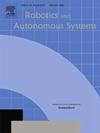DAPTP:使用时间潜能进行动态目标搜索的分布式意识规划器
IF 4.3
2区 计算机科学
Q1 AUTOMATION & CONTROL SYSTEMS
引用次数: 0
摘要
本文探讨了在复杂的大型环境中使用多个机器人搜索未知动态目标所面临的挑战。随着机器人数量和环境复杂性的增加,协调高效的分布式搜索变得更加困难。以往的方法将搜索定义为探索或利用初始目标分布来加速搜索过程。然而,这些方法无法从头开始动态建立或更新目标分布,并且在搜索过程中忽略了已搜索区域之间的差异。我们提出的 DAPTP 是一种新型的分布式感知规划器,利用时间势能进行动态目标搜索。DAPTP 的核心是时间潜能图的概念,它根据历史搜索信息估算环境中的目标分布。搜索区域的重要性根据其相应的时间潜能进行区分。在此基础上,通过最大化时间潜能变化来规划每个机器人的覆盖范围和搜索方向,确保具有最大潜能变化的区域得到优先关注。我们在模拟和实际场景中进行了大量实验。结果表明,我们的方法在减少搜索步骤、提高集体环境意识、区域搜索率、检测到的目标数量和成功率等方面都大大超过了最先进的方法。源代码见:https://github.com/arclab-hku/DAPTP。本文章由计算机程序翻译,如有差异,请以英文原文为准。
DAPTP: Distributed Awareness Planner using Time Potential for dynamic target search
This paper tackles the challenge of using multiple robots to search for unknown dynamic targets in complex, large environments. As both the number of robots and environmental complexity increase, coordinating efficient distributed searches becomes more difficult. Previous methods define search as either exploration or utilizing an initial target distribution to accelerate the process. However, these methods fail to dynamically build or update the target distribution from scratch and overlook the differences between the already searched regions during the search. We propose DAPTP, a novel Distributed Awareness Planner using Time Potential for dynamic target search. At the core of DAPTP is the concept of the time potential map, which estimates the target distribution in the environment based on historical search information. The importance of the searched regions is distinguished based on their corresponding time potential. Building on this, the coverage and search direction for each robot is then planned by maximizing the change in time potential, ensuring that areas with the greatest potential variation receive prioritized attention. We conduct extensive experiments both in simulations and real-world scenarios. The results demonstrate that our approach significantly surpasses state-of-the-art methods in terms of reducing search steps and improving collective environmental awareness, area search rate, detected target number, and success rate. The source code is available at: https://github.com/arclab-hku/DAPTP.
求助全文
通过发布文献求助,成功后即可免费获取论文全文。
去求助
来源期刊

Robotics and Autonomous Systems
工程技术-机器人学
CiteScore
9.00
自引率
7.00%
发文量
164
审稿时长
4.5 months
期刊介绍:
Robotics and Autonomous Systems will carry articles describing fundamental developments in the field of robotics, with special emphasis on autonomous systems. An important goal of this journal is to extend the state of the art in both symbolic and sensory based robot control and learning in the context of autonomous systems.
Robotics and Autonomous Systems will carry articles on the theoretical, computational and experimental aspects of autonomous systems, or modules of such systems.
 求助内容:
求助内容: 应助结果提醒方式:
应助结果提醒方式:


